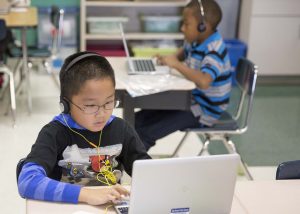Classrooms at the Intersection of Teaching and Technology
The tools of the teaching trade are changing. And Des Moines Public Schools has a new state of the art (and science) toolkit: Go Math.
“The 2015 Go Math curriculum is aligned to the Iowa Common Core State Standards,” said Anna Taggart, the district’s Elementary Math Curriculum Coordinator. “We trained over 900 DMPS teachers over the summer on Go Math and Blended Learning with a feedback score of 95% satisfaction, so it is exciting to see Go Math and the new technology being implemented in the elementary classrooms.”
Blended learning is an educational model in which a student learns partially through online delivery of content and instruction that includes an element of student control over path and pace.
“So is it a game changer – yes!” Taggart went on. “This is a big step in moving towards blended learning and technology integration in every DMPS classroom.”
As of September 19, 89% of all elementary classrooms had the new technology installed, according to Connie Broich, IT Technology Project Specialist for the district, a figure that’s revising upward on a daily basis.
So how’s it working in classrooms where it’s already up and running?
Great, if you ask Stephanie Scheer and her students. Not that we doubted them but still we accepted an invitation to come and observe their 2nd grade classroom at River Woods Elementary.
Mrs. Scheer gathered her students on the rug in front of her interactive whiteboard for a lesson about counting patterns. They cruised through a series of exercises in skip counting with lots of hands shooting up in the air and unison answers to question she posed. Go Math was in “pen mode” meaning that she was able to use a stylus to write and erase on the prepared sheets that were beaming from her computer through the projector mounted on the ceiling and onto the screen. The kids were fascinated by the seemingly magic pen.
Then, warmups out of the way, Scheer dispersed them to their desks for a couple of story problems about a bakery that sold hundreds of muffins and some students who read hundreds of pages. They worked through those together, thinking aloud, and then it was back to the rug for a demonstration of the principles behind the solutions. This time kids got the opportunity to step up to the board and enter answers with the touch of a finger. No different, really, than writing them out on a blackboard except instead of chalk dust the answers produced, seriously, oohs and aahs. There was no shortage of volunteers and there were no wrong answers as Ana, Yesenia, Patrick and Malachi, etc. took their turns climbing up the 2nd grade ladder toward the summit of the lofty thousands! Already this bunch is working in the 800’s (those story problem muffins? The Blossom Bakery sold 863, count ‘em, in one morning!)
Minutes later everyone was back at their desk at work on a page in the Go Math workbook. Quietly, Mrs. Scheer beckoned a small group aside for some focused instruction. As students completed the assigned problems they brought their workbooks forward, placed them on their teacher’s desk and checked out one of the convertible laptop/tablet computers that are being paired with the Go Math package. Off by themselves or in small groups they slapped on headphones and “played” some “Fast Math.”
Eventually one whole class was essentially divided into several subgroups working independently and quietly. Seven year-olds; almost 20 of them; hungry for lunch and anxious to get outside on the playground, working independently and quietly while their teacher focused on a select few who needed her attention most.
Go Math comes with lots of jargon like Engage Digital Video, Interactive Student Edition, Math on the Spot Video Tutor and Personalized Math Trainer. But let’s just call it engaging and leave the rest of it for the experts. Like Scheer, a sixth-year teacher whose entire career has been spent at River Woods. In the hands of a committed, enthusiastic, positive professional like her it appears that this new set of tools holds the promise of higher and wider student achievement.
This is not only a major step in improving teaching and learning through the smart use of technology, it is also a major commitment by the school district. Approximately $9 million will be invested in the adoption of the new K-5 math curriculum, which includes a four-year lease of the convertible devices, the purchase and installation of the projectors, and the license fees for software. The convertibles and projectors can be used for cross-curricular purposes. To give this some perspective, in any given year the school district will spend $1.5 million on textbook replacement alone, so much of this cost will end up being neutral.
What matters most is whether or not it makes a difference in the classroom, supporting teachers in their work to help students succeed. For Scheer, there seems to be little doubt that the answer is yes.
“It’s really so exciting to teach this way,” she said after marching her troops off to lunch and returning to talk in lieu of taking her own break. “Our district is among the first to implement Go Math on this scale and we should be so proud of that.”
Scheer put on a private demonstration that featured various ways she can use the technology in areas besides math. “And the projector has speakers, too,” she pointed out, “so I can play soft music if we’re working on some independent writing, for instance.”
Teachers perform magic with bare hands, good hearts and sharp heads. But given the best wands and other tools there’s no telling how many kids they might spellbind. On a recent Wednesday morning at River Woods Elementary School, the count in Stephanie Scheer’s room was 19.
Video of Mrs. Scheer’s Classroom at River Woods Elementary
Photos of Mrs. Scheer’s Classroom at River Woods Elementary
Created with flickr slideshow.





